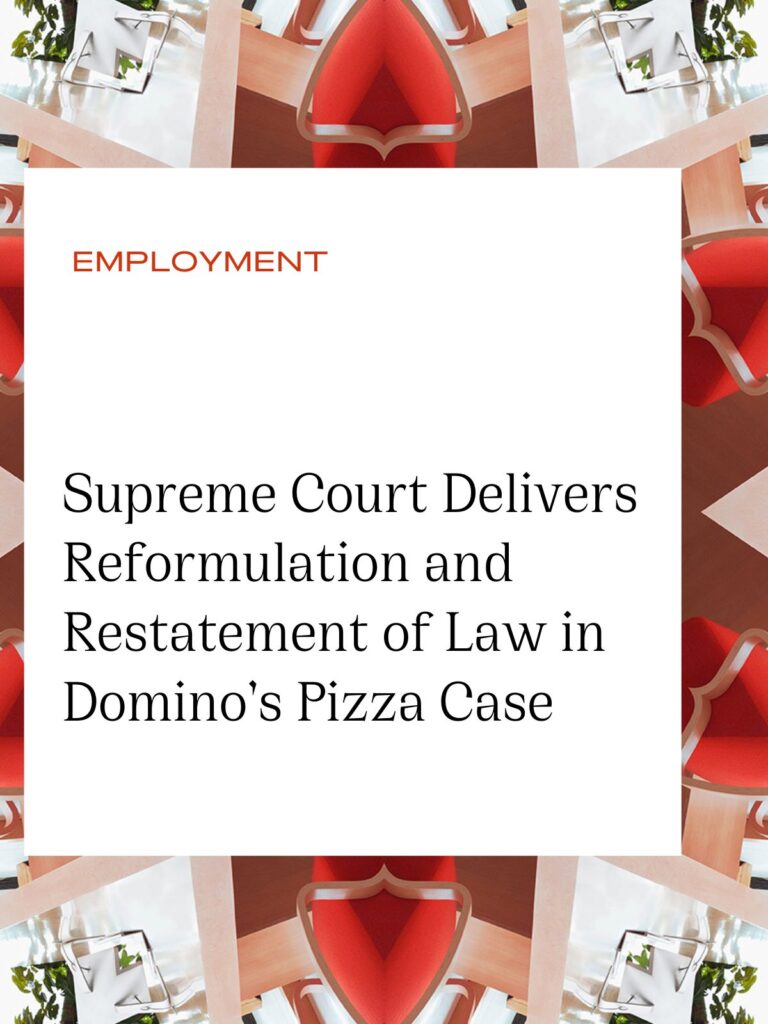
Supreme Court Delivers Reformulation and Restatement of Law in Domino’s Pizza Case
The Supreme Court in Revenue Commissioners v Karshan (Midlands) Ltd t/a Domino’s Pizza delivered a significant judgment in which it examined in detail the law in Ireland on the distinction between employees and self-employed persons and reformulated and restated that law.
Overturning the decision of the Court of Appeal, the Supreme Court held that on the facts of the case, the delivery drivers were properly categorised by Revenue as employees and not as independent contractors as was contended for by Domino’s Pizza.
Mutuality of Obligation – Not a Defining Feature of Employment Contract
Importantly, the Supreme Court rejected the contention that “mutuality of obligation” was a prerequisite for concluding that a person is rightly categorised as an employee, as distinct from a self-employed person. Specifically, the Court concluded that it was not essential that an agreement “impose an obligation to provide work and to complete that work on an ongoing basis…” for it to be classified as an employment contract.
Dominos engaged the drivers on what was referred to as an overarching “umbrella” contract. Under this contract, the drivers would confirm to Dominos their availability for work one week in advance. Only then would they be rostered for work.
The Supreme Court found that single stints of work (in this instance, the rostered work) can comprise contracts of employment, even if not accompanied in an umbrella contract by a commitment by an organisation to actually give any work in advance of these stints.
Five Step Approach to Determining Status
The Supreme Court, having disposed of the fallacy that there is a requirement for mutuality of obligation on an ongoing basis, went on to consider the tests that should be applied when determining the status of a worker. Those tests are as follows:
1. Does the contract involve the exchange of wage or other remuneration for work?
At the outset, the decision maker must satisfy itself that the parties have entered into a valid contract in the first place and then identify the precise terms of the alleged contract. For there to be a valid contract, there must be consideration i.e., a wage or other remuneration.
To qualify as an employment contract, the consideration must involve a promise of some kind by the worker to work for the alleged employer.
2. Has the worker agreed to provide their services to the employer personally?
For a contract to be a contract of employment the agreement must be one for personal service by the worker. This is the essence of an employment contract.
Some limited degree of substitution is permissible. An agreement may provide for a right of substitution only where the worker is unable to carry out the work, or with the consent of another person who has an absolute and unqualified discretion to withhold consent. The Supreme Court observed that these scenarios are consistent with a requirement for personal service.
However, an unconditional or unfettered right to substitute is inconsistent with an undertaking to provide the work or service personally. A right of substitution limited only by the need to show that the substitute is qualified to do the work is not consistent with personal performance.
In every case it is necessary to decide if the agreement is just one for personal services or whether it is an agreement that enables such unconditional delegation that it is not a contract for personal services at all.
3. A Framework of Control vs Day-to-Day Control
There must be a minimum level of control over a worker before a relationship is found capable of being an employment contract. However, the control arising at this point of the enquiry does not itself determine the issue of employment. The legally minimum element of control is a framework of control in the sense of ultimate authority rather that the concept of day-to-day control which has been a focus in previous cases.
The question is whether there is a right of control over what is to be done; at least generally the way in which it is to be done, the means to be employed in doing it, and the time when and the place where it shall be done.
For skilled work, the alleged employer will not be expected to be able to direct the worker as to how to achieve the prescribed objective. However, if the alleged employer does not have the power to direct the type of work the worker is required to do, the relationship will not be capable of constituting an employment relationship. The Supreme Court noted that there is an expectation that the organisation retain some residual authority over workers carrying out skilled work.
Similarly, if the services are provided to an organisation that does not have an entitlement to prescribe times by which the work is to be done, no power to determine where or in what conditions the work is to be done or, within an enterprise, the persons who are to do particular work, the Supreme Court believed that it is difficult to see how there can be said to be any requisite control.
4. All the circumstances of the employment
The Court concluded that the first three questions set out above should be applied as a filter, in the form of preliminary questions, which, if any are answered negatively, means there can be no contract of employment.
However, if they are all answered affirmatively, the next step it to examine the facts and circumstances to ascertain the true nature of the relationship.
The Supreme Court reframed an existing test as follows:
“Are the terms of the contact between the employer and worker interpreted in the light of the admissible factual matrix and having regard to the working arrangements between the parties as disclosed by the evidence, consistent with a contract of employment, or with some other form of contract having regard, in particular, to whether the arrangements point to the putative employee working for themselves or for the putative employer.”
In this regard, the Court noted;
- The contract must be interpreted in the light of the factual matrix in which it was concluded.
- The Court must take into account the actual dealings between the parties.
- Where the agreement seeks to characterise the status of the parties, that description does not prevent the Court from determining what, as a matter of law, the agreement actually is.
- Furthermore, “it is clear that the Court, in ascertaining the true nature of a working relationship, is not analysing an ossified arrangement: a person who begins to work on their own account, perhaps casually, may as time passes become, by reason of the frequency of their work or absorption into the employers undertaking, an employee”.
- This fourth stage of the assessment does not depend on any presumption arising from the previous three parts. It is free standing, the onus of proof being on the party who asserts any proposition of fact, law or mixed fact and law, having regard to the statutory processes in which the decision is made.
- The capacity to profit in a material way from their own skill, the need for the employee to invest significantly in their ability to undertake the work, and the requirement to bring tools or equipment to the task, all lean against the existence of a contract of employment.
- What depends on the particular facts is the place of those positives and negatives and the weight to be given to them in the balancing exercise undertaken in any case.
5. Is there anything in the particular legislative regime under consideration that requires the Court to adjust or supplement any of the foregoing?
Application of the Test
In relation to the first three questions, the Court examined the Tax Appeal Commissioner’s (“TAC’s”) earlier decision and noted that:
- there were binding legal relations between the parties involving the exchange of consideration characteristic of an employment agreement;
- the right of substitution or delegation was limited such that personal service was required; and
- Karshan exercised control over the operation of rosters, allocation of work, drivers’ manner of dress, number of deliveries, particularities in relation to insurance, preparation of invoices, directions to the drivers while on the premises etc.
On the basis of the above, the first three limbs of the test were satisfied.
In relation to all circumstances of working arrangements, the Court noted that drivers did not take calls from customers, did not employ their own labour, took no credit or economic risk, worked exclusively from Karshan’s premises, had limited ability to maximise profits, did not advertise their services and did not scale their delivery business. Additionally, the drivers were required to wear uniforms, carry branding, and deliver as instructed by managers. On that basis, they could not be said to have been engaged in their own business.
The Court therefore found that the TAC was correct to determine that the drivers were employees of Karshan for the purposes of tax assessment.
What does this mean for businesses?
The decision provides a somewhat helpful clarification on factors indicating an employment relationship.
The Supreme Court noted that the Taxes Consolidation Act 1997 does not require an element of continuity of service and as such, the question of whether the drivers accrue continuity of service for the purposes of employment rights legislation such as redundancy or unfair dismissal, is not answered by this decision of the Court.
This means that companies engaging workers in the gig economy on contracts for services may be liable for payment of pay related taxes and social contributions if those workers are found to satisfy the above test. However, where the above test is met, it may be likely that the net is cast wider and several other workers are classified as employees. It remains to be seen how this decision will be applied in the context of employment rights claims where continuity of service is by its very nature an important element. This will have significant implications on employers both from a tax as well as employment law perspective.



